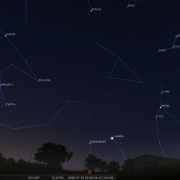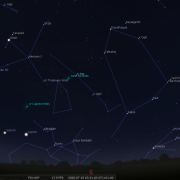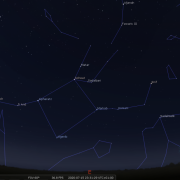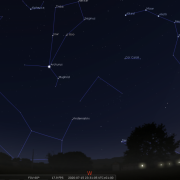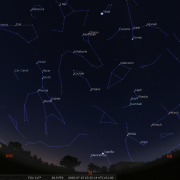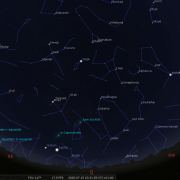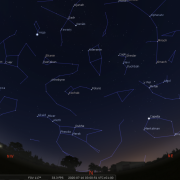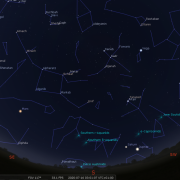In this month's Sky Notes:
Planetary Skylights
Jupiter and Saturn reach Opposition


Residing close together in the sky as they do this year, the two largest planets in the solar system; Jupiter and Saturn, both come to opposition this month. When a planet reaches opposition (those planets orbiting outside Earth’s orbit) it lies opposite the sun in the sky and hence rises as the sun sets and sets as the sun rises (more or less). A planet at opposition will also be located in the south around midnight (more or less). Planets coming to opposition during the summer in the UK will reside rather low to the horizon; this is because the ecliptic, the path along which the planets seem to move, lies low to south horizon. Consequently as ‘nights’ are still short, they will only be readily visible for five or six hours at best.
You will locate Jupiter and Saturn low to the SE around 23:00h as we head into July and shortly after 21:00h by the end of the month. Jupiter reaches opposition on the 14th and at magnitude -2.2 is by far the most conspicuous of the pair. Jupiter is a fantastic object to view with a telescope, or even binoculars. Look for the banding across the disk and the attendant Galilean moons, which offer a different configuration each night.
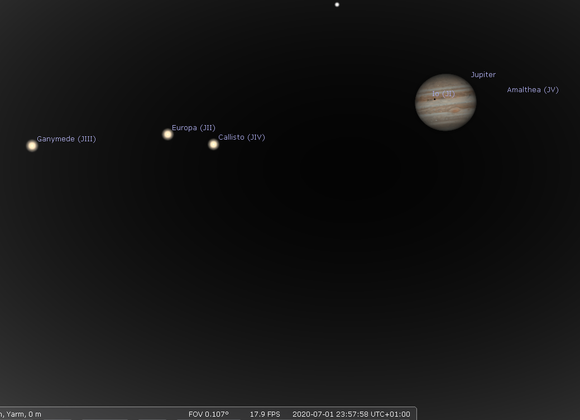
01-Jul-2020 at 23:58h: Jupiter-Io shadow transit and Great Red Spot, shortly before midnight.
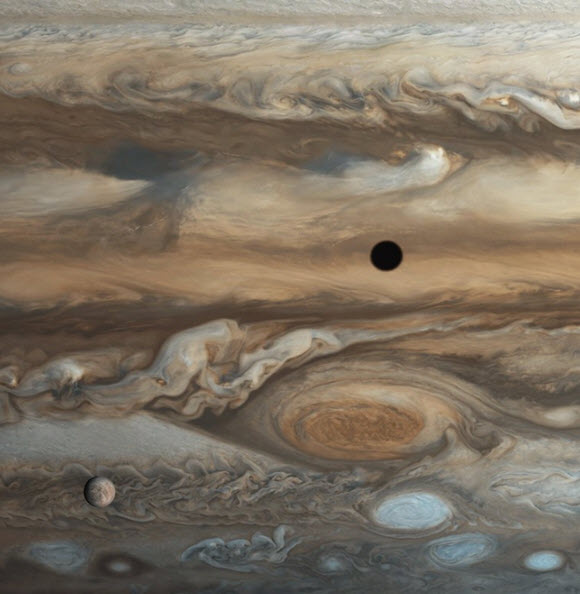
03-Mar-1979: Voyager 1 Photo of Io Transit/Shadow with Great Red Spot, taken during fly-by.
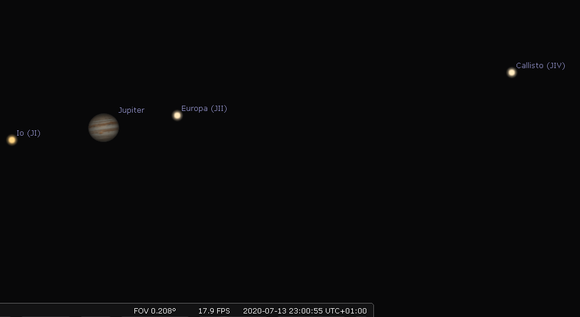
13-Jul-2020 at 23:00h: Jupiter on night of Opposition.
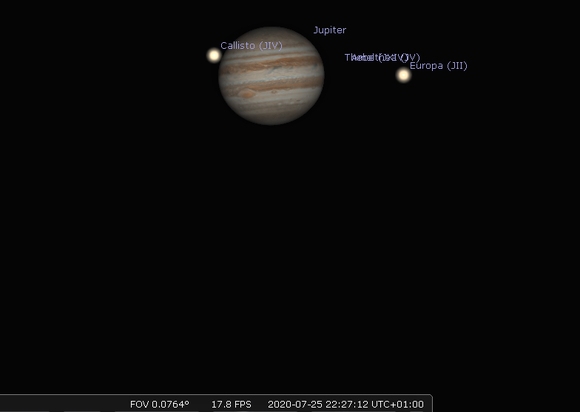
13-Jul-2020 at 22:30h: Great Red Spot visible after 22:00h
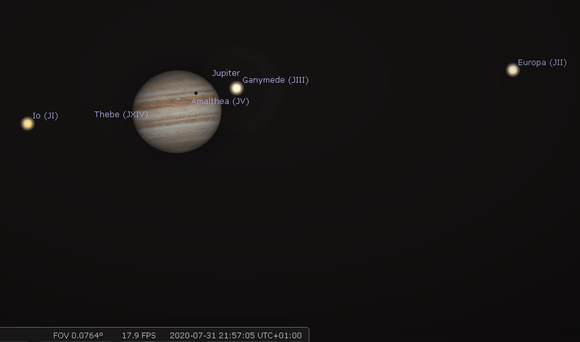
31-Jul-2020 at 22:00h: Jupiter-Ganymede shadow transit.
Larger instruments will also reveal the Great Red Spot; when it is orientated toward us.
(Jupiter actually spins in just under 10 hours-the quickest of any planet) This huge ‘hurricane’ like feature residing on the south equatorial belt, has been visible ever since the first detailed observations by a telescope were made over 400 years ago. In the last decade or so however, the GRS has diminished in size and hue by at least a third. It will be visible when Jupiter reaches opposition on the 14th. Also view on the 5th around 23:00h (or early hours of the 6th) when a Full Moon resides below Jupiter, making for an excellent photo opportunity.
The most dynamic aspect of the Jovian system, the four Galilean moons, certainly warrants attention, with an ever changing configuration noticeable even over the course of a few hours.
The Galilean moons can be seen in front of Jupiter’s disk with larger telescopes or imaging; however it is moon shadow transits which are more noticeable, visible as dark spots cast onto Jupiter’s
disk.
Galilean moon shadow transits occur on:
- 1/2nd –Io, from 23:30h
- 2/3rd – Europa from 23:00h
- 10th- Europa from 01:30h
- 17th - Io from 22:00h
- 24th – Io from 23:30h
- 26th – Callisto from 02:00h
- 31st – Ganymede, visible as soon as Jupiter rises.
The Great Red Spot is visible on Jupiter’s disk on the following dates:
- 1st – from 23:30h
- 2/3rd – from 02:30h
- 6th – from 01:00h and 22:30h
- 8th - from 23:00h
- 11th – from 01:00h
- 13th – from 02:00h and 23:30h
- 15th – from 3:45h
- 18th – from 01:00h and 22:00h
- 20th – from 02:00h and 22:45h
- 23rd – from 00:15h and again until 23:00h
- 24th – from 01:00h
- 25th – from 02:00h and from 22:00h
- 27th – from 23:15h
- 30th – from 01:00h and 21:30h
Residing midway between Sagittarius and Capricornus, Saturn reaches opposition on the 20th and is therefore visible throughout the short hours of semi darkness experienced at this time of year. Shortly following in Jupiter’s wake, Saturn will be visible roughly 40 minutes after Jupiter rises, low in the SE. With an apparent magnitude of +0.67, Saturn is considerably fainter than Jupiter, but still conspicuous to
the eye. Like Jupiter, Saturn would appear brighter, but due to the more turbulent/hazy air both planets are wading through above the southern horizon, their brightness is diminished by over half a magnitude.
Binoculars fall short of revealing the rings, but even a modest telescope should suffice. Saturn can be a wonderful sight in good seeing conditions. The rings are still well orientated, with the two main ones; ring A and ring B, separated by the Cassini division. The dark inner ring (C) will be more difficult to make out, especially with Saturn being located low down. Patience at the eyepiece will be required, but ultimately will be rewarded.
Look for Saturn’s largest moon; Titan, visible as a small, but obvious, speck of light nearby orbiting around Saturn every 16 days or so. Greatest eastern elongation of Titan occurs on 4/5th and western elongation on the 20/21st. Our moon lies in proximity to Saturn in the sky on the 5/6th, when near Jupiter also.
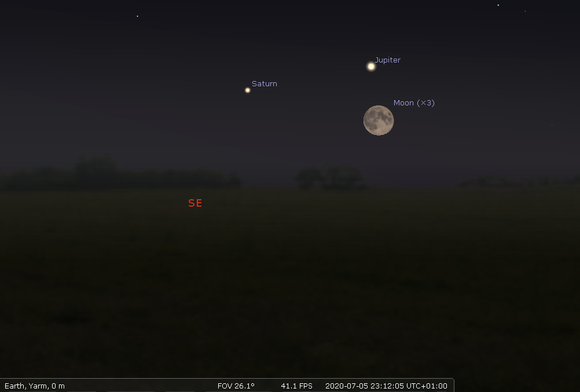
05-Jul-2020 at 23:15h (SE): Jupiter, Saturn and The Moon.
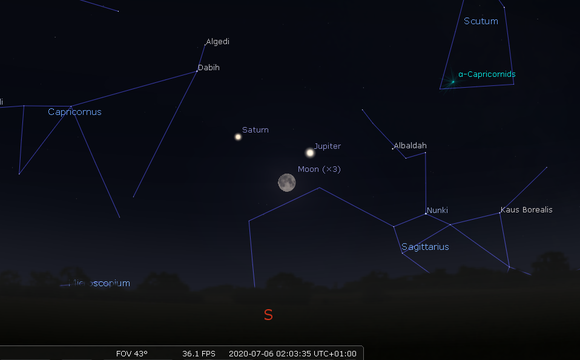
06-Jul-2020 at 23:15h (SE): Saturn, Jupiter and The Moon.
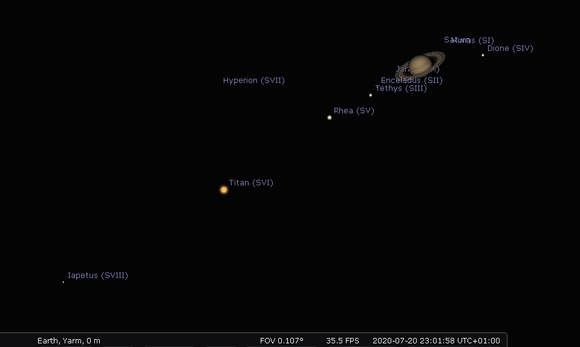
20-Jul-2020 at 23:0h (?): Saturn at Opposition.

Mars resides further round to the ESE and has a distinct orange hue. It does not rise until after midnight at the start of July, however by the end of the month Mars will be visible in the late evening sky. The red planet is gaining in brightness and is now brighter than Saturn, but still has several months before it becomes the most dominant object in the evening sky.
Telescopically, Mars remains a small disk, perhaps disappointingly small for many observers and surface detail is tricky to make out properly. Again, this will improve as Mars nears opposition in October. The waning moon passes below Mars on the 12th.
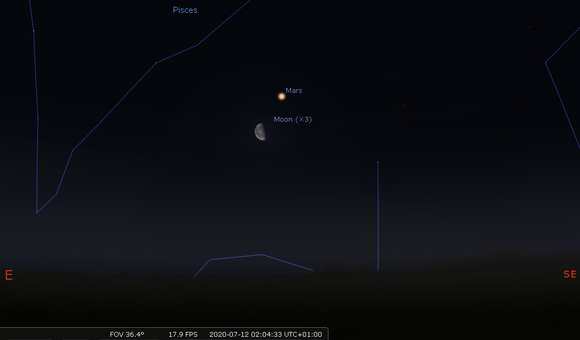
12-Jul-2020 at 02:00h (SSE): Mars and The Moon.

Venus returns to the early morning sky, although for July this is still the middle of the night!
Look for it low in the ENE from 03:30h onwards, a brilliant beacon, brighter even than Jupiter which will then be low in the SW. On the 11th Venus passes above the ‘eye of the bull’; Aldebaran in Taurus, whilst on the 17th a waning crescent moon lies above forming a triangle with Venus and Aldebaran.
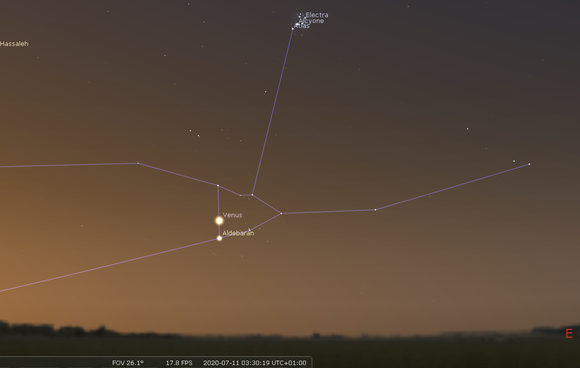
11-Jul-2020 at 03:30h (E): Venus and Aldebaren conjuction. Pleiades above.
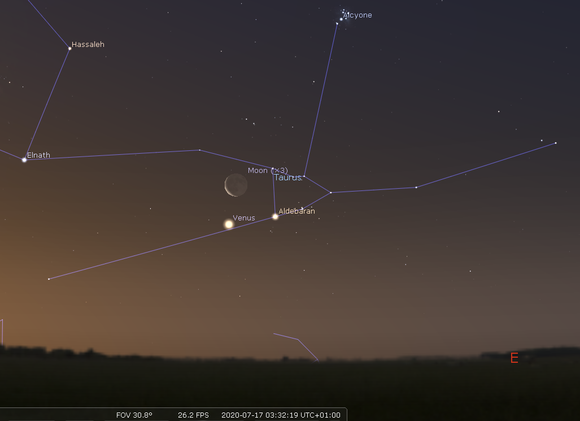
17-Jul-2020 at 03:30h (E): The Moon, Venus and Aldebaren.
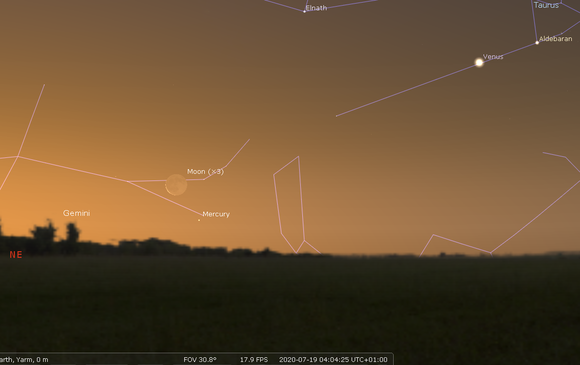
19-Jul-2020 at 04:00h (ENE): Venus, The Moon and Mercury.
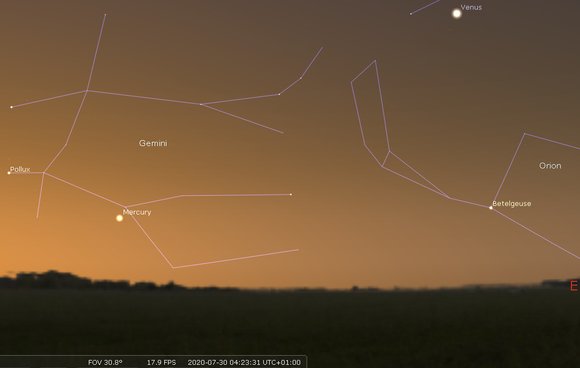
30-Jul-2020 at 04:30h (ENE): Venus and Mercury.
 Elusive Mercury also pops into the July dawn sky, although it is not the best of apparitions’. Start looking on the 19th when just after 04:00h a very slim crescent moon lies above left of Mercury. You will require a flat, unobstructed NE horizon to spot them as they are just a few degrees above it. By the end of the month Mercury will be a little higher, but considerably brighter. View around 04:30h just above the ENE horizon and you should spot it with the naked eye fairly easily.
Elusive Mercury also pops into the July dawn sky, although it is not the best of apparitions’. Start looking on the 19th when just after 04:00h a very slim crescent moon lies above left of Mercury. You will require a flat, unobstructed NE horizon to spot them as they are just a few degrees above it. By the end of the month Mercury will be a little higher, but considerably brighter. View around 04:30h just above the ENE horizon and you should spot it with the naked eye fairly easily.
Earth reaches aphelion (furthest from Sun) on July 4th, when it lies at a distance of 95 million miles or 152 million Km. This is nearly 3 million miles (4.8 million Km) more than when at its closest approach in early January.
Meteors

A number of lesser meteor showers occur during July.
- The Capri-Cornids have 3 maxima, July 8, 15, and 26, all with zenith hourly rates (ZHR) of less than 10, barely more than sporadic rates. Moon light will washout the first date, but not interfere with the other dates. Early morning hours will offer the best chance of catching a few shooting stars.
- The Alpha Cygnids peak on July 21st, but again rates are barely more than sporadic levels. Cygnus is well placed high in the SSE by midnight. Moon light will not interfere.
- The Delta-Aquarids are a little more prolific, peaking on July 30th with a ZHR of around 15. Moon light will hamper until the early hours of the morning, but this offers the best chance spotting any meteors.
Comets Galore?
Comet 2019 U6 Lemmon and Comet 2020F3 NEOWISE should both be decent binocular objects towards the end of July in Coma Berenices. Of the two Comet NEOWISE may be the most promising, but after the demise of Comet Atlas and Comet Swan, it would be foolhardy to make accurate predictions. Detailed charts are hard to come by so watch out for updates about these comets here on our website later in July; or visit https://theskylive.com for daily updates.
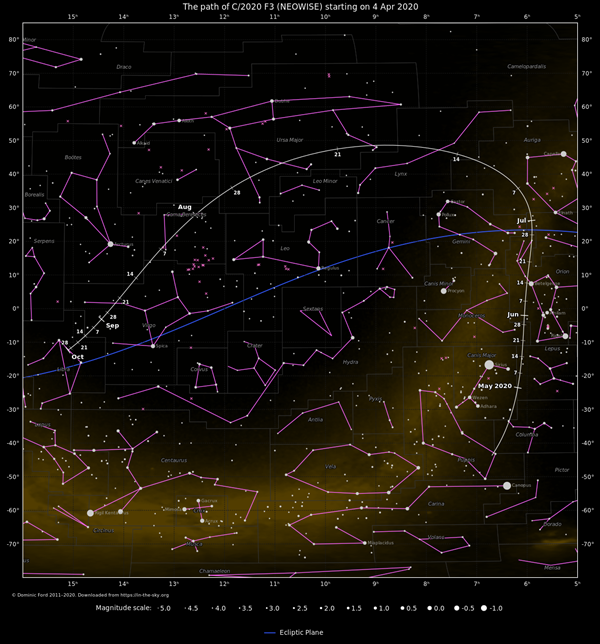
Noctilucent Cloud Watch
This will be the last opportunity to spot any displays of Noctilucent cloud until next year. Noctilucent cloud (Night shining) are rare collections of ice crystals, occasionally appearing in late clear summer evenings well after sunset because they are still reflecting sunlight due to their great height. Occupying the layer of atmosphere known as the Mesosphere, and are only seen at latitudes between 45°N and 80°N in the Northern Hemisphere, and equivalent latitudes in the southern hemisphere.
Like many clouds, noctilucent clouds need water vapour, dust, and very low temperatures to form. Low temperatures are easily attainable in the Mesosphere, but water vapour and dust are in short supply. The dust may well come from tiny meteors from space, although dust from volcanoes or man-made pollutants may add to these. Keep watch low to the north from 23:00h
Additional Image Credits:
- Planets and Comets where not otherwise mentioned: NASA
- Sky Charts: Stellarium Software
- Comet picture: in-the-sky.org
- Log in to post comments


